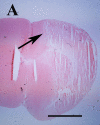Estradiol augments peri-infarct cerebral vascular density in experimental stroke
- PMID: 17509567
- PMCID: PMC2045124
- DOI: 10.1016/j.expneurol.2007.04.002
Estradiol augments peri-infarct cerebral vascular density in experimental stroke
Abstract
Peri-infarct increase of vascular density has been observed in animals and in humans with ischemic stroke. Increased peri-infarct vascular density correlates with improved functional outcome after stroke. We hypothesized that pre-treatment with estradiol will increase post-ischemic peri-infarct capillary density in a rat model of transient ischemic stroke. Estradiol, compared to placebo, augmented post-ischemic peri-infarct vascular density by 22% 10 days after stroke. Recovery of forelimb function was not improved with estradiol treatment on day three and nine post-stroke. Loss of estradiol may limit repair in the peri-infarct region by limiting angiogenesis, but functional significance in stroke recovery requires further investigation.
Figures









References
-
- Alkayed NJ, Harukuni I, Kimes AS, London ED, Traystman RJ, Hurn PD.Gender-linked brain injury in experimental stroke Stroke 199829159–165. discussion 166 - PubMed
-
- Ardelt AA, McCullough LD, Korach KS, Wang MM, Munzenmaier DH, Hurn PD. Estradiol regulates angiopoietin-1 mRNA expression through estrogen receptor-alpha in a rodent experimental stroke model. Stroke. 2005;36:337–341. - PubMed
-
- Chen J, Li Y, Zhang R, Katakowski M, Gautam SC, Xu Y, Lu M, Zhang Z, Chopp M. Combination therapy of stroke in rats with a nitric oxide donor and human bone marrow stromal cells enhances angiogenesis and neurogenesis. Brain Res. 2004;1005:21–28. - PubMed
-
- Chen J, Zhang ZG, Li Y, Wang Y, Wang L, Jiang H, Zhang C, Lu M, Katakowski M, Feldkamp CS, Chopp M. Statins induce angiogenesis, neurogenesis, and synaptogenesis after stroke. Ann Neurol. 2003;53:743–751. - PubMed
MeSH terms
Substances
Grants and funding
LinkOut - more resources
Full Text Sources
Medical

